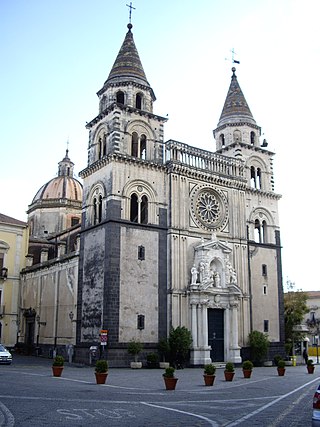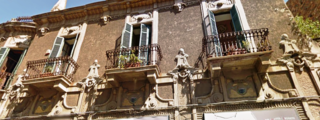
The province of Caltanissetta is a province in the southern part of Sicily, Italy. Following the suppression of the Sicilian provinces, it was replaced in 2015 by the free municipal consortium of Caltanissetta. The province contains 22 comuni. Its coat of arms is a red crest and two green leaf stems on top with a laurel leaf on the right and a crown in the middle. The River Salso is the main river of the province; it is 122 kilometres (76 mi) long and originates in the province of Palermo, and it flows into the Mediterranean in this province at the end of the Gulf of Gela.

The province of Syracuse was a province in the autonomous island region of Sicily, Italy. Its capital was the city of Syracuse, a town established by Greek colonists arriving from Corinth in the 8th century BC. It had an area of 2,109 square kilometres (814 sq mi) and a total population of 403,985 (2016). Syracuse had 8% of the Sicilian population and 8.2% of Sicily's area.

The University of Catania is a university located in Catania, Sicily. Founded in 1434, it is the oldest university in Sicily, the 13th oldest in Italy, and the 29th oldest university in the world. With a population of over 60,000 students, it is the main university in Sicily.

Stadio Angelo Massimino is a multi-use stadium in Catania, Italy. It is used mostly for football matches and the home of Calcio Catania. The stadium was built in 1935 by architect Raffaele Leone on behalf of the company owned by Antonio Ferro and holds 23,266 people. It was renamed in 2002 after former Catania chairman Angelo Massimino (1927–1996).

The Teatro Massimo Bellini is an opera house located on Piazza Vincenzo Bellini in Catania, Sicily, southern Italy. Named after the local-born composer Vincenzo Bellini, it was inaugurated on 31 May 1890 with a performance of the composer's masterwork, Norma. It seats 1,200.

The Orto Botanico dell'Università di Catania, also known as the Hortus Botanicus Catinensis, is a botanical garden in Catania, Sicily, southern Italy. It is operated by the University of Catania botany department. This institution is a member of BGCI, with international identification code CAT.

The Plain of Catania is the most extensive and most important plain in Sicily.
The Gulf of Catania is an inlet of the Ionian Sea on the eastern coast of the Italian island of Sicily.

Acireale Cathedral is a Roman Catholic cathedral dedicated to the Annunciation of the Blessed Virgin Mary in the city of Acireale in Sicily, province of Catania, Italy. It was declared the seat of the Bishop of Acireale in 1870.

The Palazzo Biscari is a monumental private palace located on Via Museo Biscari in Catania, Sicily, southern Italy. The highly decorative interiors are open for guided tours, and used for social and cultural events.

The Palazzo Tezzano is a monumental palace in Piazza Stesicoro, in the center of Catania, Sicily, southern Italy. The via Etnea, with prominent shops, bisects the Piazza; this palazzo rises at the northwest intersection with this via, across from the white stone, neoclassical Palazzo Paterno del Toscano.
Grassy Precinct, formerly township, is Congressional Township 10 South, Range 1 East of the Third Principal Meridian located in Williamson County, Illinois. It is named for Grassy Creek, which has since been used to create Little Grassy Lake.

The Monastery of San Nicolò l'Arena in Catania, Sicily is a former Benedictine monastery, located on Piazza Dante 30 in the city of Catania, region of Sicily, Italy. After the Mafra, this abbey is the second largest Benedictine monastery in Europe. It is now a UNESCO World Heritage Site, and houses the Department of Humanities of the University of Catania.

The Giardino Bellini is the oldest urban park of Catania.
The Accademia di Belle Arti di Catania is an academy of fine arts located in Catania, Sicily. It was founded in 1967 and started its activities in January 1968. As of 2013, it was the third academy of fine arts in Italy for number of students.
Gaylor is an unincorporated community in Wayne County, in the U.S. state of Missouri. The community was on the Black River south of Clearwater Lake approximately one mile north of Leeper.
Chrysaoris was a town of ancient Caria, perhaps afterwards called Idrias (Ἰδριάς). According to Apollonius, in his Carica, it was the first city which was founded by the Lycians. According to Marcus Mettius Epaphroditus, all Caria was called Chrysaoris. Herodotus mentions a district in Caria, named Idrias, in which the river Marsyas had its source. Later, Antiochus built the city of Stratonicea there.

The Palazzo Paternò del Toscano, also known as the Palazzo del Toscano, is an notable palace in Piazza Stesicoro, in the center of Catania, region of Sicily, southern Italy. The building now houses many shops, but is also used by schools, and for cultural programs. The white stone facade stands before the Monument to Vincenzo Bellini and rises in contrast to the palace across via Aetna, the white and black Palazzo Tezzano.
The Clementi Clinic is a former surgical facility located on Viale Regina Margherita in Catania, region of Sicily, Italy. It was erected in 1904 and designed by Carlo Sada in a Liberty style. It presently houses offices of the Intesa San Paolo bank. The building is remarkable for the large windows in the upper floor used to provide natural light for the surgical suite.

The Garage Musumeci is an notable building, elaborated in a flamboyant Liberty style, and built to house both an automobile showroom on the ground floor and above the apartments of the owner, Baron Musemeci. It is located in Piazza Bovio, at the intersection of Via Conte di Torino and Via Francesco Crispi, in the city of Catania, region of Sicily, Italy.














